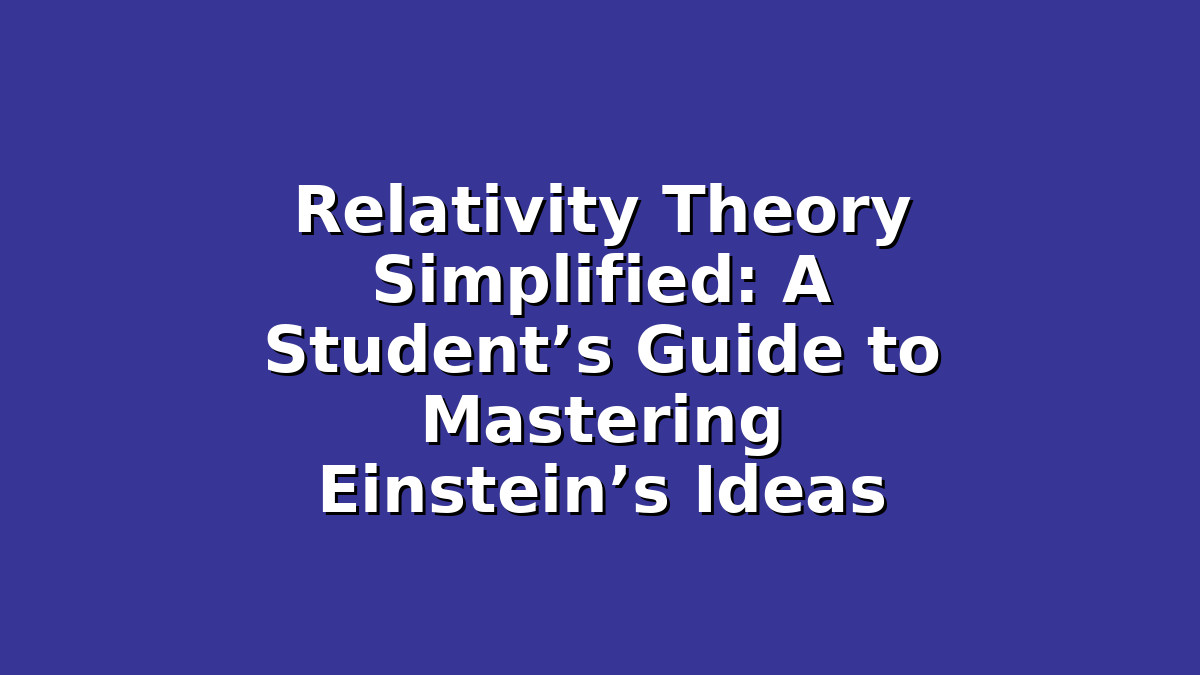Introduction
If you’re a student preparing for exams or simply trying to grasp key concepts in physics, the theory of relativity can seem intimidating at first. Renowned physicist Albert Einstein revolutionized our understanding of space, time, and gravity with his theory of relativity—yet many find its ideas complex or abstract. The good news? Relativity theory doesn’t have to be confusing. By breaking it down into manageable parts and using effective study techniques, you can understand the core principles and ace that exam!
In this article, we’ll simplify Einstein’s theory of relativity and provide practical study tips tailored to help students like you succeed. Whether you’re tackling special relativity, general relativity, or both, this guide will help you build confidence and deepen your understanding. Let’s get started!
Section 1: Understanding the Basics of Relativity—What You Need to Know
Before diving into detailed equations or advanced concepts, it’s important to understand what relativity is fundamentally about. Einstein’s theory actually consists of two parts:
1. Special Relativity (1905): This part deals with objects moving at constant speeds, especially near the speed of light, and introduces the idea that space and time are linked.
2. General Relativity (1915): This extends the theory to include gravity, showing how massive objects bend space-time itself.
Key Concepts to Focus On:
– The Speed of Light is Constant: No matter your speed, you always measure light traveling at about 299,792 kilometers per second.
– Time Dilation: Moving clocks tick slower compared to stationary clocks. This means time can pass at different rates depending on speed.
– Length Contraction: Objects moving close to the speed of light appear shorter along the direction of motion.
– Gravity as Curved Space-Time: Instead of thinking of gravity as a force pulling objects, general relativity describes it as objects moving along curves in a warped space-time fabric.
Study Tip:
Create simple summaries or flashcards for these core concepts. Use diagrams to visualize time dilation and space curvature. Visual aids help cement abstract ideas in your memory. For example, sketch a rubber sheet bent by a heavy ball to represent gravity’s effect on space-time.
Section 2: How to Approach the Math Without Feeling Overwhelmed
Relativity involves math, including algebra, geometry, and sometimes calculus. But don’t let formulas scare you off—focus first on understanding what they represent.
Study Tip 1: Break down equations into words. For example, the famous equation from special relativity, E = mc², can be interpreted as: energy (E) equals mass (m) times the speed of light (c) squared. This shows mass and energy are interchangeable.
Study Tip 2: Practice unit analysis to check your work. Understanding which units you’re working with can prevent confusion.
Study Tip 3: Work on example problems step-by-step. Start with simple questions about time dilation or length contraction before moving to more complex problems on gravitational time dilation or the bending of light.
Study Tip 4: Use online simulations and videos. Watching animations of relativistic effects can make the math feel more intuitive.
Stay patient with yourself—mathematical fluency comes with time and practice. If you hit a tough problem, break it into smaller parts, and don’t hesitate to seek help from teachers or study groups.
Section 3: Effective Study Strategies for Exam Success
Relativity concepts can be heavy and abstract, so it’s essential to adopt productive study habits:
1. Spaced Repetition: Review key concepts regularly over days or weeks instead of cramming. This improves long-term retention, especially for definitions and terminology.
2. Teach What You Learn: Try explaining relativity concepts to a friend, family member, or even aloud to yourself. Teaching is a proven way to clarify your understanding.
3. Connect Ideas: Relate relativity to everyday experiences or other subjects. For example, GPS satellites use general relativity corrections to stay accurate. Understanding real-world applications helps make the theory more tangible.
4. Use Mnemonics and Analogies: Create memory aids or analogies. For example, think of time dilation like watching a slow-motion replay of events when you move very fast.
5. Past Papers & Practice Questions: Practice with past exam questions or quizzes to familiarize yourself with how questions are phrased and the problem-solving approaches expected.
6. Stay Positive and Take Breaks: It’s easy to get discouraged by tricky topics. Keep a growth mindset—your brain can learn and improve with effort. Also, take regular breaks to avoid burnout and boost focus.
Conclusion
Einstein’s theory of relativity might seem like a tough topic at first, but with the right approach, you can simplify it and master the concepts. Start by understanding the fundamental ideas of special and general relativity, use visual tools to aid comprehension, and tackle the math step-by-step without rushing. Employ smart study methods like spaced repetition, teaching, and practical problem-solving to build confidence and prepare effectively for exams.
Remember, physics is not just about memorizing formulas but about developing a clear and logical understanding of how the universe works. With patience, curiosity, and consistent study, relativity can become one of your favorite physics topics!
Good luck with your studies—you’ve got this!

Responses